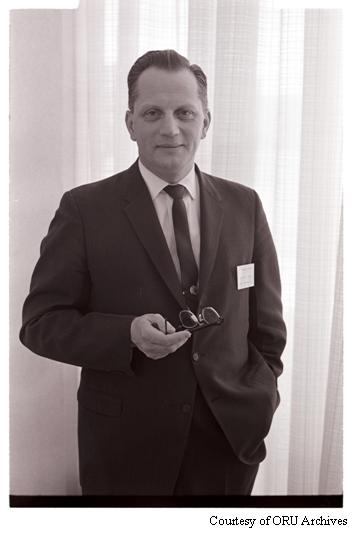Pilgrimage Into Pentecost: The Pneumatological Legacy of Howard M. Ervin
Pastor Isgrigg introduces us to Professor Ervin and how he helped shape the landscape of today’s Pentecostal/charismatic movement.

Introduction
Howard M. Ervin, a Baptist and Pentecostal scholar, paved the way for other scholars to defend the Pentecostal faith in the academic world. During the last half of the twentieth century, charismatics, evangelicals and Pentecostals scholars have debated the nature and function of Spirit baptism. Early in the debate, Howard Ervin offered a view of Spirit baptism that centered on Luke’s unique pneumatology in Luke-Acts and meaning of the term “filled with the Spirit.” Ervin’s work, These Are Not Drunken as Ye Suppose (1968), was one of the first books to enter the scholarly debate from the Pentecostal position. Some of the leading Evangelical scholars, such as Anthony Hoekema and James D. G. Dunn, would offer a critique of Ervin and the growing Pentecostal position in the early 70’s. In response, Ervin offered his own rebuttal against renowned New Testament scholar James Dunn’s treatment of the Pentecostal position in Conversion-Initiation and Baptism in the Holy Spirit.1 Today scholars are still debating the nature of Spirit baptism and what it means to be filled with the Spirit. But since that time, Pentecostals views have been more readily accepted in the academic arena. The Society for Pentecostal Studies is a demonstration of the broad level of interest in Pentecostal areas of study. With the explosion of new perspectives on Pentecostal issues, there can be a tendency to focus on the latest ideas. For variety of reasons, Pentecostal scholarship has moved beyond the theology and exegesis offered by Howard Ervin. As the dialogue continues and new insights are brought forth, fewer scholars are integrating Ervin’s ideas. Though his works were written in a different time, Howard Ervin’s pneumatology can speak to the theological issues of today.
Ervin has also been on the cutting edge of the ecumenical movement. In a tradition that has a history of exclusion; Ervin was able to effectively bring the Pentecostal experience to thousands of believers from traditional denominations. Through a tradition of scholarship and a legacy of ecumenism, Howard Ervin’s “Pilgrimage into Pentecost” can continue to inform and inspire the next generation of Pentecostals.
Biography
Howard Matthew Ervin was born into the family of Harry and Florence Ervin on September 21st, 1915 in the small coal mining town of St. Nicholas, Pennsylvania. After graduating from high school, this self-described “practical agnostic” had little interest in religion until he encountered the witness of a Baptist minister one day in his father’s barber shop in Mahanoy City, PA.2 As he was considering the minister’s words one evening, Jesus appeared to him in his room and he saw him face to face. That night, December 23rd, 1939, Howard Ervin entered the kingdom of God at the age of 25. Recognizing his call to ministry Ervin pursued his training at Eastern Baptist Theological Seminary in Philadelphia. It was at Eastern where he met his Latvian-born bride to be, Marta Vaskis.3 Dr. and Mrs. Ervin married in April of 1944. Together they would eventually have three daughters, Gretchen, Deborah and Judith as well as five grandchildren and four great grandchildren.4 Ervin continued his education at Eastern as he completed his B.A. and Th.B. degree. He also earned a M.A. in Near Eastern Studies from Asia Institute and a B.D. from New Brunswick Theological Seminary.5 As impressive as the previous four degrees were, Ervin went on to receive a Th.D. in Old Testament Studies from Princeton Theological Seminary while ministering in New Jersey. With a keen theological mind and a scholar’s vocabulary, Ervin has the ability to speak on any biblical or theological subject with excellence.
Though he is a scholar of impeccable credentials, Ervin has a pastor’s heart. On January 17th, 1946, Howard Ervin was ordained by the Northern Baptist Convention of New Jersey. Ervin’s first opportunity to pastor came when he was asked to fill the vacant pulpit of Dr. A.L. Murray, the man who had witnessed to him in his father’s barbershop. He was appointed as the interim pastor at the First Baptist Church in Lansdale, Pennsylvania while Dr. Murray fulfilled his military chaplain position. Three years later, in February of 1946, he left Pennsylvania for Atlantic Highlands, New Jersey to pastor Central Baptist Church. He was recommended by the previous pastor, Richard Shearer who was Ervin’s classmate at Eastern Baptist Seminary. After three years, Ervin left Central and founded Emmanuel Baptist Church in February of 1949. It was his seventeen years there that would be the fertile ground for the experiences that would fuel over fifty years of Pentecostal belief and teaching.
Pilgrimage into Pentecost
During his time at Eastern, Ervin studied under what he calls a “rare group of men.”6 He credits one professor, Dr. Adams, with a philosophy of interpreting Scripture by the maxim, “What does the text say?”7 Because of Ervin’s commitment to good exegesis he has been able to “depart from traditional theology if the text supports it.”8 It is this very principle that would lead Ervin on what he calls his “Pilgrimage into Pentecost.”9 Determined to preach only what the scripture teaches, Ervin prided himself on exegetical, verse-by-verse teaching of the whole Bible. This commitment to the text brought him to the realization that he was living under the experience of believers that was communicated in the Bible. He recalls, “When I read the Scriptures it made my own experience seem like another world. If my experience was normative, there was something wrong with the Scriptures. If the Scriptures were normative, there was something wrong with my experience and the experience of the church as I know it.”10


